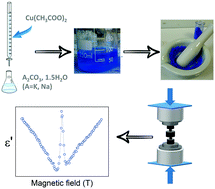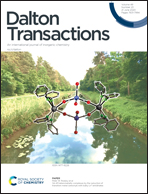Synthesis, sintering by Cool-SPS and characterization of A2Cu(CO3)2 (A = K, Na): evidence for multiferroic and magnetoelectric cupricarbonates†
Abstract
We report here the synthesis and densification of two magnetic materials in the system A2Cu(CO3)2 (A = Na, K). Based on literature data, the synthesis route has been modified to offer the possibility of gram-scale production with high powder purity. The cool spark plasma sintering (Cool-SPS) method has been used to obtain highly dense samples (>95% of theoretical density). Not only did the sintering method prove its efficiency for giving dense ceramics, but it also extended the stability domain of both compounds to higher temperatures. The case of Na2Cu(CO3)2 is highly instructive of the possibilities offered by the Cool-SPS technique, since the pure phase can be obtained during the sintering process, while it is impossible through conventional heat treatments in a furnace. Obtaining dense ceramics allowed the exploration of dielectric properties, leading to the observation of a step-like anomaly in K2Cu(CO3)2 similar to some multiferroic systems, while Na2Cu(CO3)2 exhibits an interesting magnetocapacitance evolution, probably linked to a magnetoelectric coupling.



 Please wait while we load your content...
Please wait while we load your content...